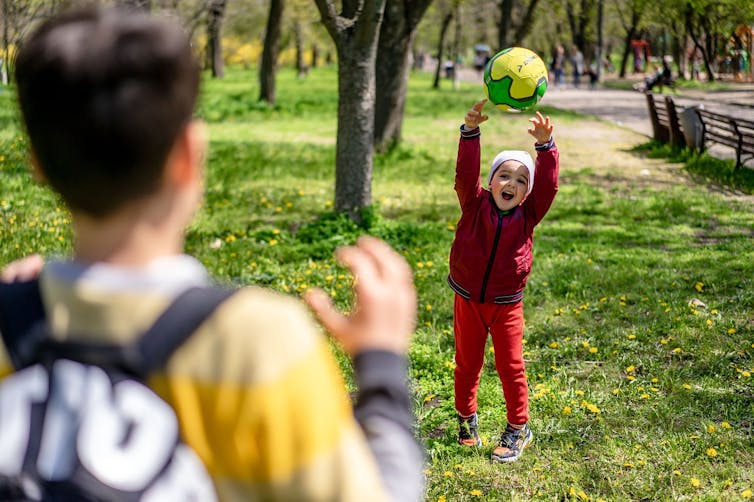Mark S Tremblay, L’Université d’Ottawa/University of Ottawa and Nicholas Kuzik, L’Université d’Ottawa/University of Ottawa
Appropriate levels of physical activity, sedentary behaviour and sleep (collectively termed movement behaviours) are essential for the healthy growth and development of preschool-aged children.
This was the impetus for creating the Canadian 24-Hour Movement Guidelines for the Early Years (birth to four years). Likewise, this is why the World Health Organization adopted the Canadian guidelines when creating the global guidelines on physical activity, sedentary behaviour and sleep for children under five years of age.
Considering the extensive benefits of movement behaviours, it is very alarming that a recent study found that only 14 per cent of preschoolers around the world are meeting movement behaviour guideline recommendations.
A 24-hour day in the life of a preschooler meeting the guideline recommendations includes:
- three or more hours of total physical activity (including at least one hour of energetic play or activities that make them slightly out of breath),
- one hour or less of screen time, and
- 10 to 13 hours of good quality sleep
Importantly, preschoolers who meet these guidelines gain health benefits such as reduced risk of obesity, improved social and emotional skills, and proficient motor skills.
Global levels

(Pixabay/Oleksandr Pidvalnyi)
A new global study shows most children around the world don’t meet these guidelines. The study included more than 7,000 preschoolers from 33 different countries, including Canada. The countries represented various World Bank income groups (e.g., high, middle and low income countries); and the geographical regions of Africa, Americas, Eastern Mediterranean, Europe, Southeast Asia and Western Pacific.
When looking at each movement behaviour individually for preschoolers around the world, 49 per cent met the physical activity recommendations, 42 per cent met the screen time recommendation, and 81 per cent met the sleep recommendation.
That most young children are not meeting each of these basic recommendations separately is cause for concern; that 86 per cent are not meeting all guideline recommendations combined is alarming and places preschoolers around the world at risk of sub-standard health and development.

(Shutterstock)
Seventeen per cent of boys met all the guideline recommendations, compared to 13 per cent of girls. This slight difference was driven by more boys meeting the physical activity recommendation (56 per cent boys, 42 per cent girls), and protected from being even worse by more girls meeting the screen time (45 per cent girls, 38 per cent boys) and sleep (82 per cent girls, 79 per cent boys) recommendations.
The fact that boys had more screen time and less good quality sleep could be related, as previous research has found screen time overall and screen time in the evening is associated with less sleep and lower sleep quality.
Better screen time and sleep habits for girls protected their overall movement behaviour adherence from being even worse, showcasing the various paths to health through different movement behaviour combinations. However, the low number meeting all movement behaviour recommendations demonstrates the need for all preschoolers to routinely be more active, reduce screen time and accumulate good quality sleep in a day.
By income

(Shutterstock)
Low-income countries had the highest movement behaviour guideline adherence levels (17 per cent), compared to middle-income (12 per cent) and high-income (14 per cent) countries.
While children from high-income countries were more active and had more quality sleep, they also had the worst screen time behaviours compared to low- and middle-income countries. It is a double-edged sword that in higher-income countries, children have more access to physical activity opportunities and quality sleep environments, but also more access to screen time devices.
Likewise, middle-income countries with the lowest movement behaviour adherence rates could symbolize a region’s development transition where infrastructure in the homes and communities cannot yet support more physical activity and good quality sleep, but availability of cell phones, televisions and other screens leads to increased sedentary behaviours.
By region
The African and European regions had the highest movement behaviour adherence (24 per cent), while the Americas region had the lowest (eight per cent). With 17 per cent meeting the screen time recommendations and 68 per cent meeting the physical activity recommendations, the Americas region had the worst screen time and best physical activity.
The physical activity levels of the Americas region preschoolers are higher compared to the 39 per cent of older Canadian children and youth as reported in the ParticipACTION Report Card on Physical Activity for Children and Youth. But these older Canadian children and youth did have slightly better, albeit still poor, screen time behaviours with 27 per cent meeting the guidelines.
Sixty-eight per cent of preschool-aged children in the Americas were meeting the physical activity recommendations, compared to only 26 per cent of Southeast Asian children. However, it remains a concern that roughly half of all young children around the world are at risk of sub-optimal health and development from lack of physical activity.

(Shutterstock)
Guidance for improvements can be drawn from the World Health Organization’s Global Action Plan on Physical Activity, where the goal of a 15 per cent relative reduction in global physical inactivity rates by 2030 relies on capacity-building collaborations within research organizations and alliances to strengthen our global understanding of movement behaviours.
Along with the best movement behaviours overall, the African region had the best screen time levels with 63 per cent meeting the recommendations. This is potentially explained by limited access to screen time devices.
However, to better understand why screen time behaviours are better in Africa, initiatives like the Active Healthy Kids Global Alliance Global Matrix project should be used as a model. Within the Global Matrix, region-level differences are an opportunity to learn the strengths of other regions, while addressing regional weaknesses at home.
For instance, Canada could be a model for less active countries, while attempting to model the African region’s reduced screen time lifestyles. Further, projects such as the SUNRISE study — where researchers from more than 70 countries are collaborating to measure preschoolers’ movement behaviours, health and development — are excellent venues for this necessary capacity-building and global learning.
Take home
The WHO has Global Movement Guidelines for preschool children and a Global Action Plan to increase physical activity. Canada has similar guidelines and a similar plan.
However, health movement behaviour levels in Canada and across the globe are unsatisfactory and forecast further global health challenges, inequalities, and distancing from United Nations Sustainable Development Goals. It’s time to get our little ones a little more active.![]()
Mark S Tremblay, Professor of Pediatrics in the Faculty of Medicine and Senior Scientist at the CHEO Research Institute, L’Université d’Ottawa/University of Ottawa and Nicholas Kuzik, Postdoctoral Fellow, CHEO Research Institute, L’Université d’Ottawa/University of Ottawa
This article is republished from The Conversation under a Creative Commons license. Read the original article.


Recent Comments